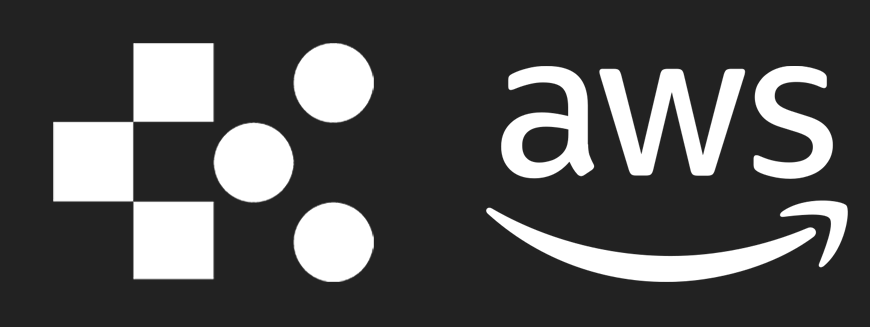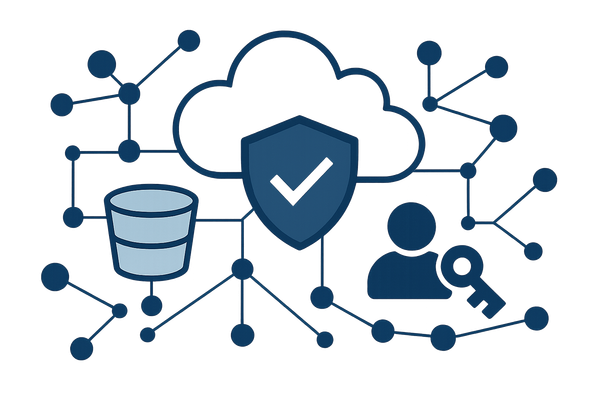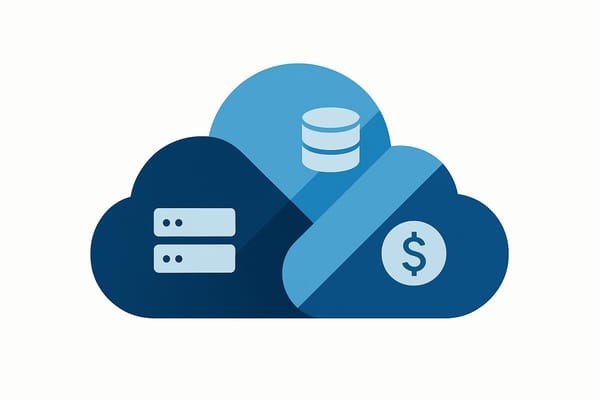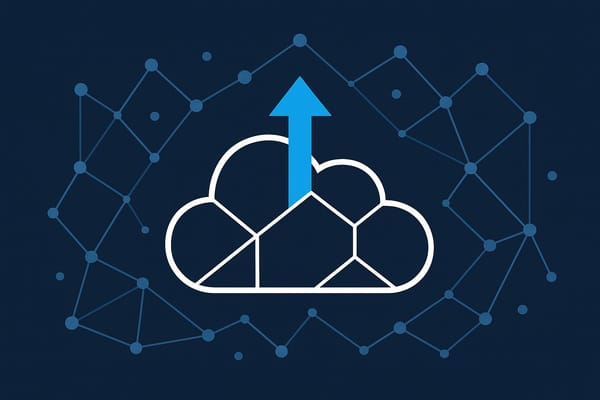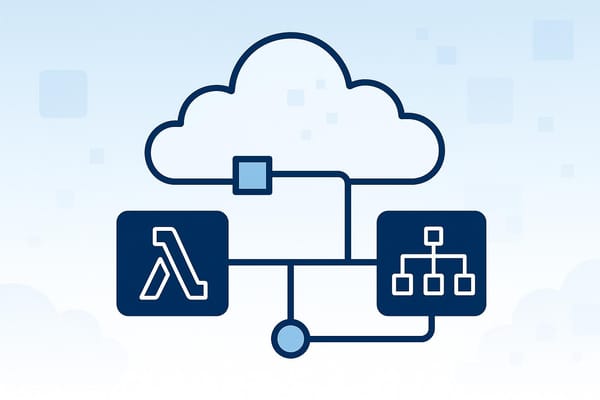Checklist for Setting Up AWS Vulnerability Management
Learn how to implement effective AWS vulnerability management in five key steps, reducing risks and automating security processes for small businesses.
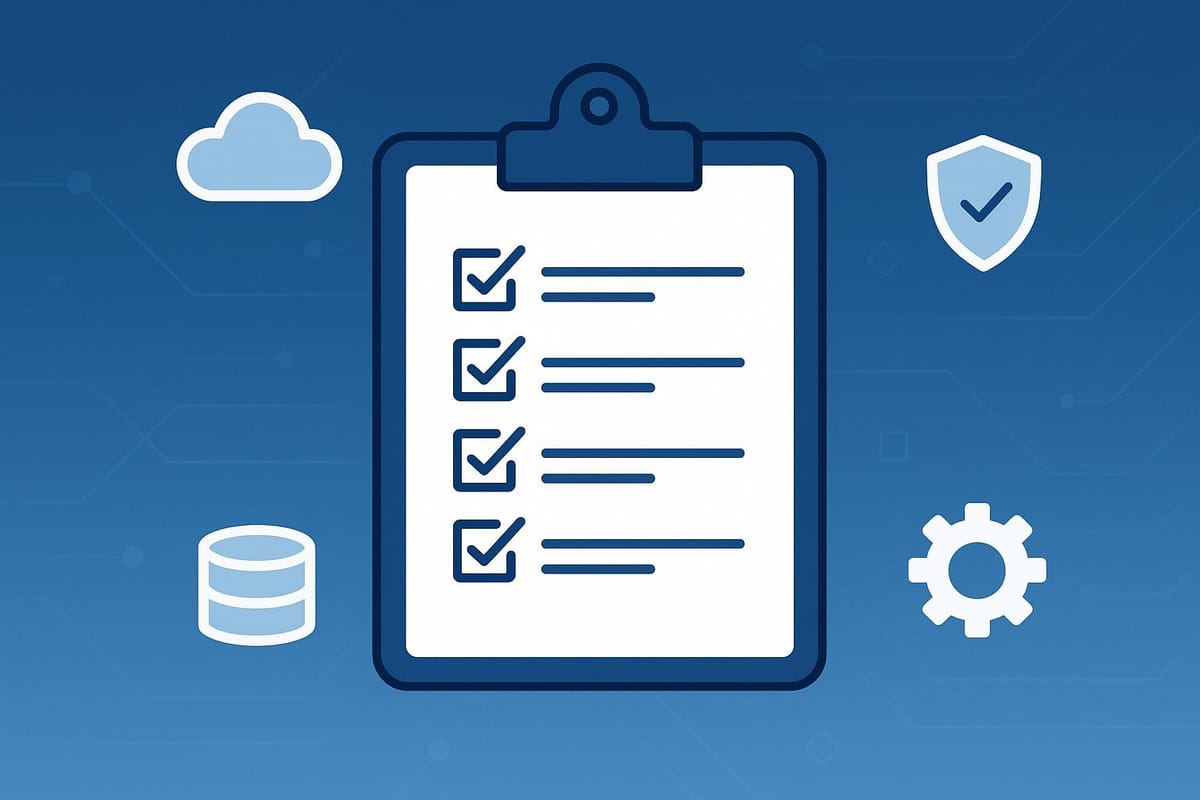
Over half of small businesses face cyberattacks, and 60% shut down within six months after one. If you're using AWS, setting up vulnerability management can help protect your business. This guide outlines five key steps to secure your AWS environment, automate processes, and reduce risks.
Here's what you'll do:
-
Step 1: Configure Security Basics
- Enable AWS Config and CloudTrail for monitoring.
- Set up Identity and Access Management (IAM) with MFA and least privilege access.
- Turn on AWS Security Hub for centralised threat analysis.
-
Step 2: Automate Vulnerability Scanning
- Use Amazon Inspector for EC2, containers, and Lambda.
- Add third-party tools from AWS Marketplace for extra coverage.
- Schedule scans with EventBridge to catch issues early.
-
Step 3: Automate Patch Management
- Use AWS Systems Manager Patch Manager for automatic updates.
- Organise patching with tags and Maintenance Windows.
- Generate compliance reports to track patch status.
-
Step 4: Monitor and Respond to Threats
- Set CloudWatch Alarms for real-time alerts.
- Automate fixes with AWS Lambda.
- Test incident response with regular simulations.
- Step 5: Ensure Compliance
Why it matters: SMBs often lack resources to recover from cyberattacks. AWS tools like Security Hub, Inspector, and Config simplify vulnerability management, making enterprise-level security affordable and scalable.
Follow this checklist to protect your business, save time with automation, and maintain compliance.
AWS Vulnerability Management with Amazon Inspector Hands-On Workshop
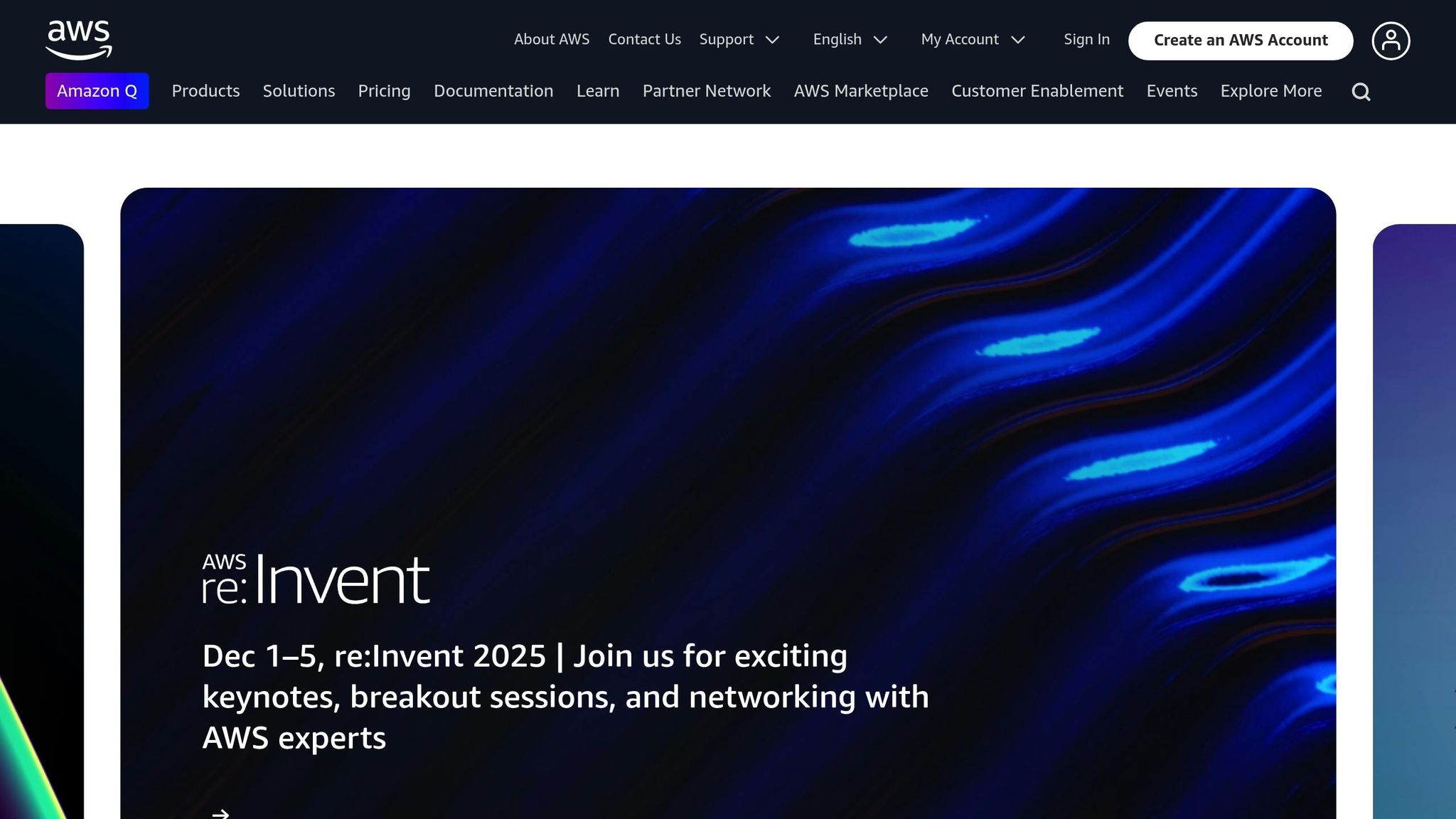
Step 1: Set Up Basic Security Configuration
Begin by establishing a solid security foundation. Enable three essential AWS services that provide visibility, control, and monitoring across your AWS environment. This groundwork is crucial for implementing automated scanning and patch management in later steps.
Enable AWS Config and CloudTrail
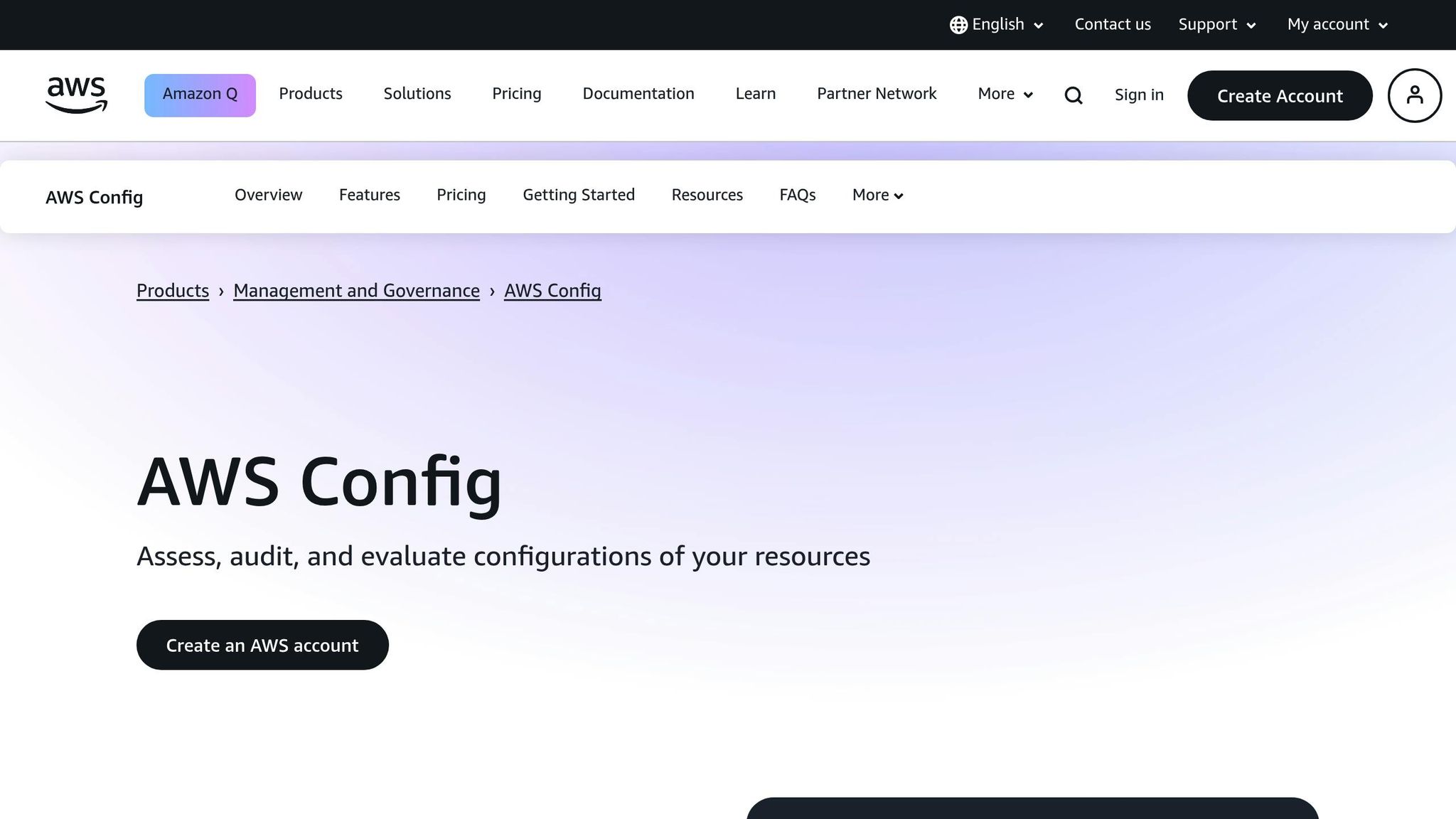
AWS Config and CloudTrail are essential for building a robust security monitoring system. AWS Config tracks changes to your resources, while AWS CloudTrail logs API actions, offering detailed auditing capabilities. Together, they ensure that when AWS Security Hub performs compliance checks and flags issues, it relies on accurate, up-to-date information.
Configure Identity and Access Management (IAM)
Misconfigured IAM settings can leave your environment vulnerable. As Tiexin Guo, Senior DevOps Consultant at Amazon Web Services, puts it:
"Security is job zero".
To safeguard your environment, implement multi-factor authentication (MFA) for all users, avoid using root credentials for daily operations, and rely on IAM roles for temporary access with automatic rotation. For multi-account environments, integrate AWS IAM Identity Center with your existing identity systems. Regularly rotate credentials and remove outdated access keys to ensure permissions align with actual usage. As AWS advises:
"grant only the permissions required to perform a task".
Turn On AWS Security Hub
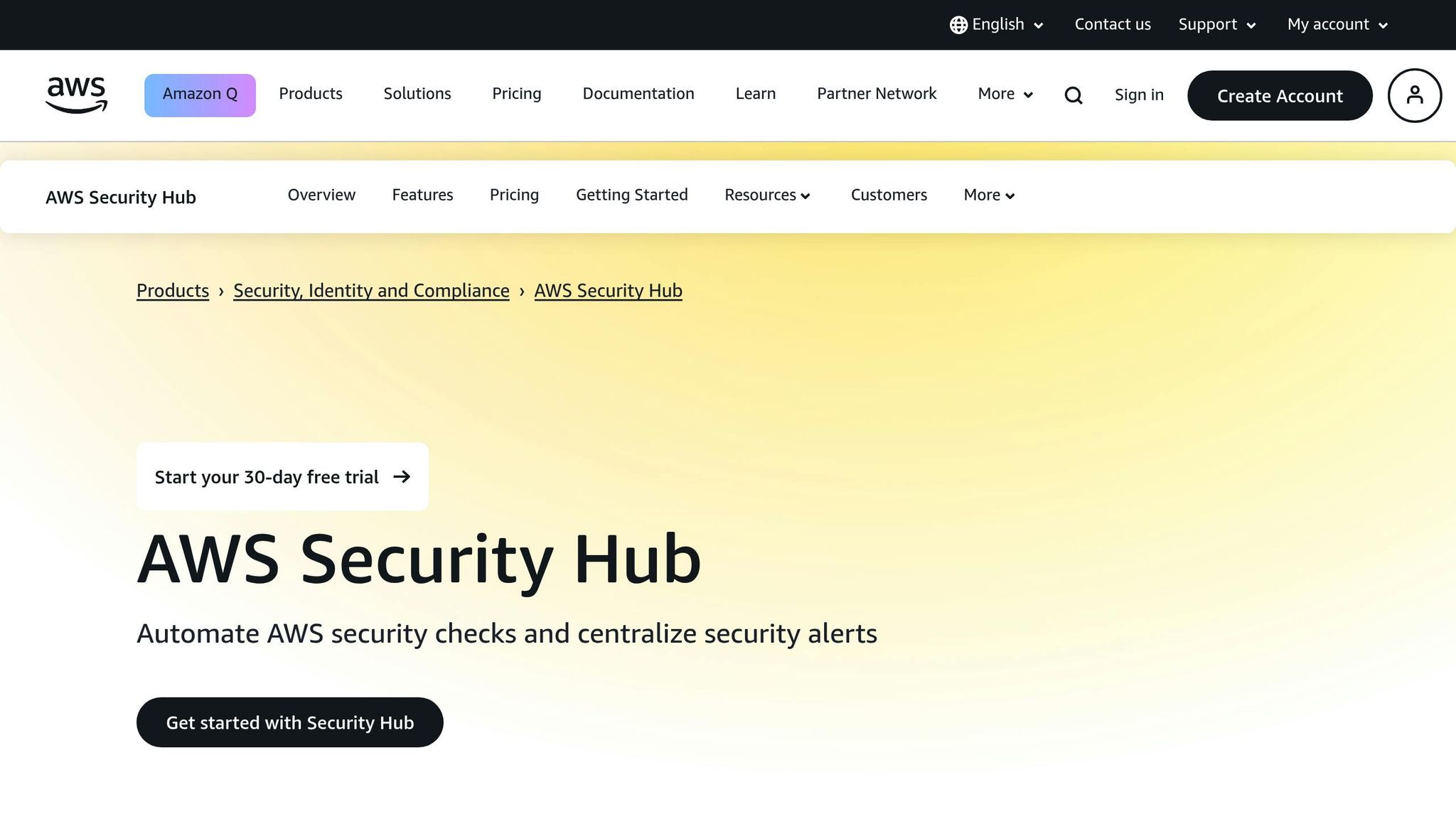
AWS Security Hub acts as your centralised security dashboard, consolidating and analysing findings from various AWS services and third-party tools. Adam Novotný, AWS Presales Consultant, highlights its value:
"Security Hub in general saves your time by creating accurate reports on security gaps in your AWS environment".
Security Hub leverages machine learning to identify threats and integrates seamlessly with key AWS services. It supports multiple security standards, including AWS Foundational Security Best Practices, CIS, PCI DSS, and NIST. Enable Security Hub in all supported AWS Regions to achieve comprehensive coverage.
For small and medium-sized businesses, Security Hub is particularly accessible, offering a free tier with 10,000 finding ingestion events per month. It calculates security scores and identifies accounts and resources that need immediate attention, helping you prioritise your efforts effectively.
To get the most out of Security Hub, ensure AWS Config is continuously recording resource changes. This allows Security Hub to produce accurate findings and perform ongoing security checks. Its automated remediation features let you define custom actions to address specific security issues, reducing the manual workload for your team. With these foundational configurations in place, you're ready to move forward with automated vulnerability scanning.
Step 2: Set Up Automated Vulnerability Scanning
After establishing a solid security foundation in Step 1, the next priority is to implement automated scanning to uncover vulnerabilities in your AWS environment. With tools running continuously, you can catch potential issues early - before they escalate into major problems. This step focuses on integrating automated scans with your existing security setup, ensuring seamless coverage without the need for constant manual input.
Set Up Amazon Inspector for EC2 and Containers
Amazon Inspector simplifies vulnerability scanning for your EC2 instances and container images with minimal effort. Once activated, it automatically enables all scan types - covering EC2, Lambda, and ECR container image scanning - and starts discovering workloads immediately. For EC2 instances, you can choose between agent-based scanning (via the AWS Systems Manager Agent) or agentless scanning, which uses EBS snapshots to compile a software inventory.
New AWS accounts can try Amazon Inspector free for 15 days, giving you a chance to explore its capabilities before incurring any costs. While basic ECR scanning focuses solely on vulnerabilities in operating system packages, Inspector goes further by also checking programming language packages. Plus, it provides continuous scanning, not just evaluations triggered by image pushes. You can manage costs effectively by using inclusion rules to specify which ECR repositories should be scanned, ensuring critical images are monitored consistently.
Inspector also supports automated rescans triggered by key events like new CVE publications, software updates, or changes to Lambda functions. To exclude specific resources from scans, you can use tags. For instance, tag EC2 instances with InspectorEc2Exclusion to skip them. For Lambda functions, apply tags like InspectorExclusion with the value LambdaStandardScanning to exclude standard scans or InspectorCodeExclusion with the value LambdaCodeScanning to skip code scans. For multi-account and multi-region setups, the inspector2-enablement-with-cli tool can help automate activation.
Add Third-Party Scanners from AWS Marketplace
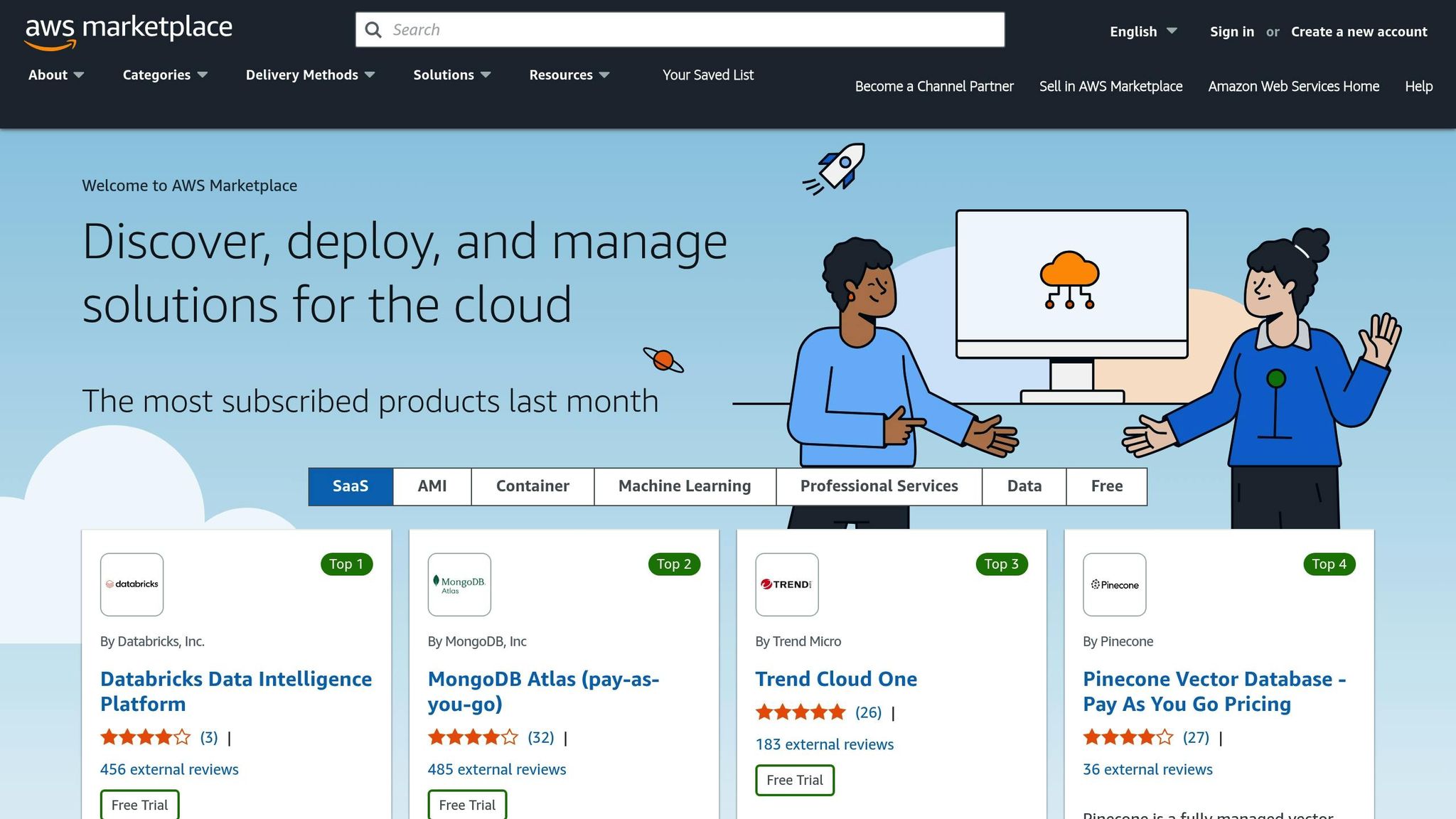
AWS Marketplace offers a range of third-party scanning tools to complement Amazon Inspector. These tools can detect vulnerabilities and security gaps that may not be covered by AWS-native services. The marketplace model eliminates upfront licence fees, allowing you to pay only for what you use, with costs consolidated into your AWS bill.
Incorporating security scanning earlier in your development process - known as the "shift left" strategy - can prevent vulnerabilities from making it to production. When choosing third-party scanners, look for tools that integrate with your CI/CD pipelines and offer actionable guidance for fixing issues. This approach not only enhances your security posture but also streamlines remediation efforts.
Schedule Regular Scans with EventBridge
Amazon EventBridge makes it easy to automate and schedule vulnerability scans at regular intervals. Its flexible scheduler allows you to define rules using cron expressions for precise timing or rate expressions for consistent intervals, such as hourly or daily scans.
For example, to schedule daily scans at 09:00 UTC, you can use the following command:
aws events put-rule --name "DailyAutomationRule" --schedule-expression "cron(0 9 * * ? *)"
When setting up EventBridge targets, ensure that the necessary IAM permissions are in place. This allows EventBridge to trigger services like Systems Manager Automation runbooks or Lambda functions to carry out the scans. Additionally, EventBridge can integrate with Amazon Inspector to send alerts for new findings or state changes. For small to medium-sized businesses with limited security resources, this automated setup offers enterprise-grade protection without requiring a dedicated team.
Step 3: Automate Patch Management
Once vulnerabilities are identified through automated scanning, the next step is to fix them efficiently. Automating patch management ensures that vulnerabilities are addressed quickly and consistently, reducing the chances of human error. This is particularly helpful for small and medium-sized businesses (SMBs) that might lack extensive IT resources. Tools like AWS Systems Manager Patch Manager can simplify this process by automating patching across your infrastructure.
Configure AWS Systems Manager Patch Manager
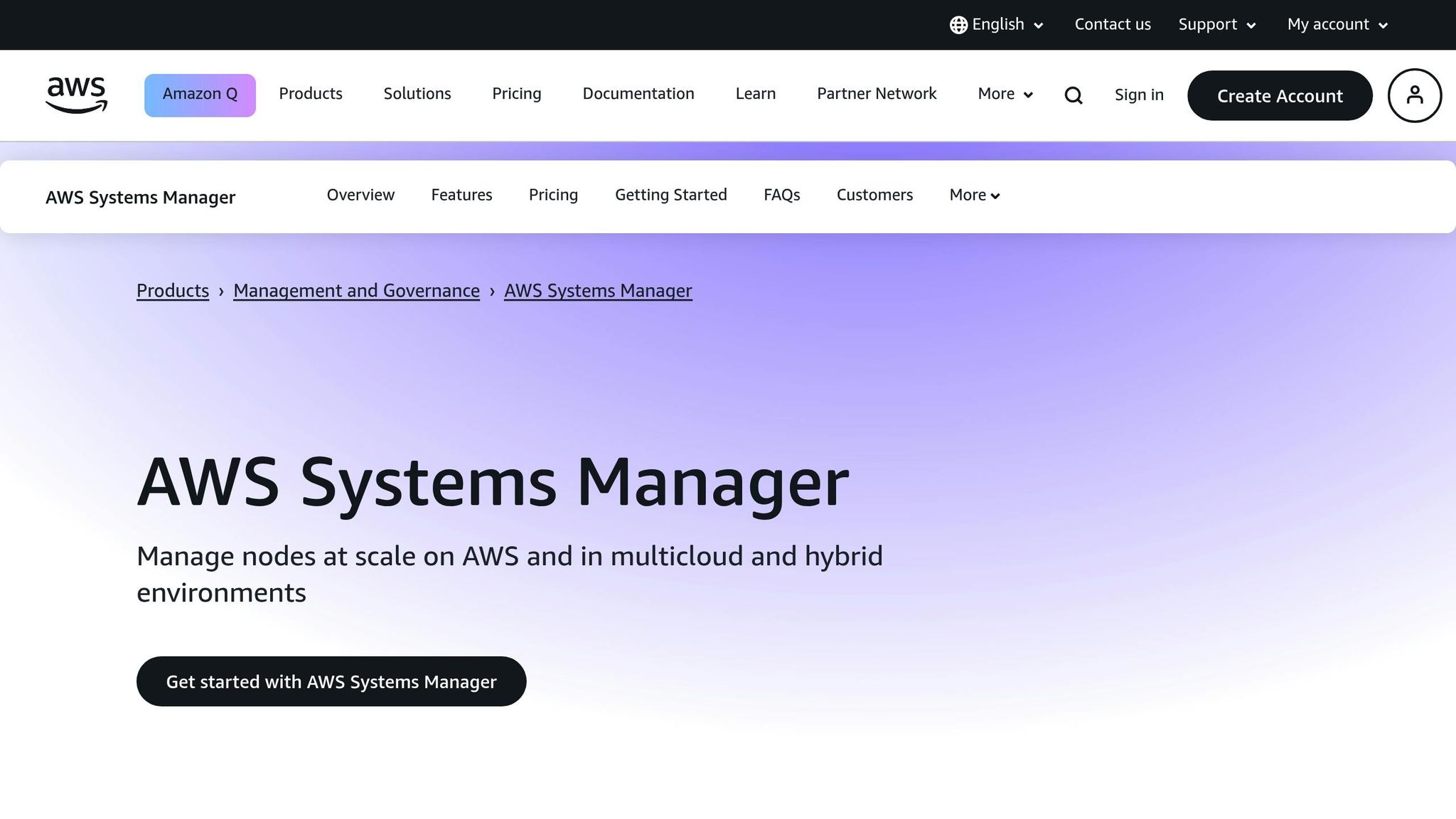
AWS Systems Manager Patch Manager allows you to automate updates for operating systems and applications on EC2 instances. You can define patch baselines with rules for automatic approvals and maintain lists of approved or rejected patches. For instance, you could set up a baseline to auto-approve critical updates shortly after release while requiring manual approval for feature updates.
Patch policies make it easier to manage patching at scale. Using the Quick Setup feature, you can define policies that target your entire organisation, specific organisational units, regions, or individual accounts. This flexibility lets you customise patching schedules to fit different environments. For example, you might immediately apply updates to development instances while scheduling updates for production systems during designated maintenance windows.
Organising instances into groups or using tags can further streamline patching. Patch groups allow you to categorise instances by their purpose or environment. Development servers, for example, might receive updates immediately, whereas production systems could follow a more controlled schedule.
AWS Senior Consultant Stefan Minhas has showcased how patch baselines can be configured to auto-approve patches within a set number of days after their release. He also demonstrated how patch groups can help organise instances for patching and how to schedule regular updates using Maintenance Windows tasks.
Once your patching setup is configured, schedule updates during low-impact periods using Maintenance Windows.
Create Maintenance Windows
Maintenance Windows allow you to schedule patching during times when system activity is minimal. This is especially useful for larger deployments, as Systems Manager reboots each node after applying patches to ensure updates are fully implemented.
When planning maintenance windows, consider your business's operational hours and critical processes. For many SMBs, weekends or late-night hours are ideal for patching. Larger deployments may require additional planning. For example, AWS Managed Services (AMS) limits each maintenance window to 300 target instances. If you manage a large number of instances, you might need to schedule multiple windows to cover them all:
| Instances to Patch | Maintenance Window Duration (hrs) | Concurrent Windows Needed |
|---|---|---|
| 100 | 1 | 1 |
| 200 | 1 | 1 |
| 300 | 2 | 1 |
| 600 | 3 | 2 |
| 800 | 4 | 3 |
| 1,200 | 6 | 4 |
| 1,500 | 8 | 5 |
AMS also creates snapshots before patching, making it possible to roll back changes if needed. For urgent updates that can't wait for a scheduled maintenance window, you can use the Run Command feature to execute the AWS-RunPatchBaseline document for immediate patching.
Set Up Patch Compliance Reporting
Patch compliance reporting transforms your patching efforts into actionable insights, providing a clear picture of your security posture and ensuring you meet organisational standards. These reports are also useful for audits and demonstrating diligence to stakeholders.
Patch Manager can generate compliance reports in CSV format, giving you detailed visibility into patch status. For example, individual reports can identify specific patch IDs linked to non-compliance, while organisation-wide reports summarise non-compliant nodes. You can also automate notifications using AWS Lambda, EventBridge, and SNS, enabling a quick response to issues.
In January 2025, the AWS Cloud Operations Blog highlighted an advanced solution for automating patch reporting. This setup uses AWS Lambda, EventBridge, Step Functions, and DynamoDB to produce detailed patch operation reports in CSV format. It also supports email notifications via Amazon SNS or SES and integrates with AWS Chatbot for Slack notifications. This approach provides insights into both successful and failed patch operations.
Ongoing monitoring of patch compliance is essential for addressing non-compliant instances promptly. By integrating AWS Config and CloudWatch Events, you can automate reporting and notifications, ensuring compliance issues are resolved quickly. Additionally, maintaining detailed records of all patching activities and testing patches in non-production environments before applying them to critical systems helps minimise risks and maintain security standards.
For a more comprehensive view of your overall security, integrating AWS Security Hub can consolidate patch compliance data with other security findings. This centralised approach simplifies security management, especially for SMBs without dedicated security teams.
Step 4: Monitor and Respond to Vulnerabilities
Once automated patching is in place, the next step is to focus on real-time monitoring and quick responses to vulnerabilities. For small and medium-sized businesses (SMBs) with limited IT resources, this phase is critical. It connects automated patching with proactive threat management, ensuring vulnerabilities are addressed promptly.
Set Up CloudWatch Alarms for Vulnerability Alerts
Amazon CloudWatch Alarms can be a game-changer for real-time security monitoring. These alarms notify you of critical security issues as they arise. They can track a variety of metrics, such as findings from Amazon Inspector, alerts from Security Hub, or even custom security events tailored to your environment.
To keep things manageable, configure alarms to trigger based on the severity of vulnerabilities. For instance, you could set up instant alerts for critical vulnerabilities while scheduling daily summaries for medium-severity issues. This approach reduces the risk of alert fatigue while ensuring that urgent matters are prioritised.
By integrating CloudWatch Alarms with Amazon SNS, you can deliver these alerts through multiple channels, such as email, SMS, or Slack. For larger teams, consider creating separate notification groups based on severity levels or the type of system affected.
CloudWatch Alarms also allow you to monitor custom metrics from your applications and infrastructure. This means you can track application-specific security indicators alongside AWS’s standard security findings. This comprehensive visibility ensures you’re not only alerted to vulnerabilities but are also well-equipped to act on them immediately.
Automate Fixes with AWS Lambda

After detecting vulnerabilities, AWS Lambda can help automate the remediation process, speeding up response times. Lambda functions are particularly useful for SMBs, as they can handle common vulnerabilities without requiring manual intervention.
Using EventBridge rules, you can trigger Lambda functions whenever Amazon Inspector flags critical vulnerabilities. These functions can automatically update outdated packages, apply patches, or execute custom remediation actions. For example, if a vulnerable library is identified, Lambda can take immediate steps to resolve the issue.
When deploying Lambda for remediation, security must remain a top priority. Always apply the principle of least privilege when assigning IAM roles to your Lambda functions, ensuring they only have the permissions they absolutely need. Additionally, validate all inputs in your Lambda code to prevent command injection vulnerabilities. Regularly review and remove unused functions to minimise potential security risks.
For more advanced scenarios, Lambda can isolate compromised instances or coordinate multi-step remediation processes across different AWS services. This flexibility makes it a powerful tool for handling complex security challenges.
Test Incident Response with Simulations
Testing your incident response capabilities is essential to ensure your team is prepared for real-world security incidents. Simulations provide a safe way to evaluate tools, refine communication strategies, and practise responding to various attack scenarios.
AWS suggests incorporating "gameday" exercises as part of your incident response routine. These exercises not only test whether AWS services correctly respond to alarm events but also simulate real incidents. This dual approach helps teams fine-tune their procedures and gain a clearer understanding of how to manage actual threats.
Aim to run simulations on a quarterly basis, covering a variety of attack scenarios such as compromised credentials or multi-stage breaches. Document the lessons learned from each exercise and use them to update your incident response plans.
It's important to involve all relevant stakeholders in these simulations. This includes technical teams, management, and even external partners. A well-rounded approach ensures that communication channels are effective and everyone understands their role during an incident.
To make your testing even more robust, vary the timing and conditions of these simulations. Running exercises during weekends, holidays, or off-hours can expose gaps in your coverage, ensuring your response capabilities remain strong no matter when an incident occurs.
Step 5: Maintain Compliance and Generate Reports
This final step focuses on creating a compliance framework that not only meets regulatory requirements but also provides auditors with the visibility they need. Building on earlier steps like monitoring and patch management, this phase transforms vulnerability management into a proactive compliance strategy.
Configure AWS Config Rules for Compliance Standards
AWS Config Rules are designed to continuously evaluate your resources against regulatory standards, automatically flagging any deviations from compliance requirements.
Conformance packs are particularly useful here. These packs group Config rules with remediation actions to establish a quick compliance baseline. AWS even offers sample templates for major regulatory frameworks such as PCI DSS, HIPAA, FedRAMP, and NIST-800 standards. For businesses managing multiple AWS accounts, conformance packs can be deployed across the organisation from a master or delegated admin account.
"Security and Compliance is a shared responsibility between AWS and the customer. This shared model can help relieve the customer's operational burden as AWS operates, manages and controls the components from the host operating system and virtualisation layer down to the physical security of the facilities in which the service operates." - AWS Compliance
Custom Config rules allow organisations to address their specific needs using AWS Lambda functions or Guard, a policy-as-code language. For multi-account setups, centralising the Lambda function in a single account simplifies management and reduces operational complexity.
Change-triggered custom rules take compliance monitoring to the next level. These rules evaluate resources whenever a configuration change occurs, ensuring that compliance violations are identified immediately rather than during scheduled assessments. This real-time capability is crucial for maintaining security in dynamic environments.
In terms of cost, AWS Config charges £0.002 per configuration item recorded, with additional fees for rule evaluations based on the number performed. This makes it a cost-effective option for comprehensive compliance monitoring.
Once your compliance rules are in place, the next step is to transform all that data into actionable reports.
Create Regular Compliance Reports
Using data from AWS Config and Security Hub, reporting tools can enhance your compliance oversight. AWS Security Hub consolidates security findings across your AWS environment and generates security scores for each standard, account, and organisation. This scoring system provides instant insights into your compliance status, helping you pinpoint areas that need attention. It also consolidates findings across multiple standards, showing how specific misconfigurations impact your overall security score.
For historical and audit-ready data, tools like Amazon Athena and AWS Audit Manager are invaluable. Audit Manager simplifies audit preparation with prebuilt frameworks tailored to various compliance standards.
| Framework | Automated Controls | Manual Controls | Control Sets |
|---|---|---|---|
| PCI DSS v4.0 | 108 | 172 | 15 |
If you need access to AWS's own compliance documentation, AWS Artifact provides on-demand access to security and compliance reports.
Organisation-wide aggregators further simplify compliance management by centralising data across all AWS accounts. Using Config's Advanced queries feature, you can query resource configuration and compliance data from one location.
The AWS Config Control Compliance report is particularly detailed, offering information such as the date, AWS account ID, rule description, compliance status, resource type, severity, remediation category, and delta metrics. This ensures auditors have everything they need without requiring additional documentation.
Regular internal, executive, and quarterly reports help maintain continuous compliance and keep your organisation audit-ready.
AWS's compliance portfolio supports 143 security standards and certifications, with over 500 security-focused features and services. This gives small and medium-sized businesses access to enterprise-level compliance capabilities without the complexity or high costs typically associated with such solutions.
Conclusion: Building Strong AWS Security
Setting up effective vulnerability management in AWS isn't just about ticking boxes - it’s about creating a proactive, streamlined approach that combines automation, continuous monitoring, and compliance management. With the right strategy, what might seem like an overwhelming task becomes a manageable process.
Automation plays a key role in achieving robust AWS security, especially for SMBs. It allows businesses to keep pace with the ever-evolving threat landscape while staying competitive. In fact, in 2024, over 33% of identified vulnerabilities were classified as critical or high severity.
The stakes are high. Back in 2021, small businesses in the US alone faced an estimated £2.4 billion in cybercrime-related costs. However, by implementing the automated vulnerability management strategies outlined here, SMBs can achieve the kind of security typically associated with larger enterprises - without the hefty price tag or complexity. Proactive monitoring and patching, as discussed earlier, form the backbone of this approach.
Regular security reviews are essential for maintaining a strong AWS security posture. While annual reviews are a good starting point, increasing the frequency to bi-annual or even quarterly reviews helps businesses stay ahead of emerging threats. As your business grows, so must your vulnerability management strategy. AWS tools like Security Hub, Inspector, and Config provide the flexibility and scalability needed to align security measures with organisational growth.
Emerging technologies, particularly AI, are also reshaping the security landscape. With two-thirds of security professionals now expecting AI to outpace traditional methods in threat detection, integrating AI-driven solutions into your security framework can significantly enhance your ability to respond to new challenges. By adopting the automation frameworks discussed in this checklist, your SMB can not only safeguard current operations but also prepare for future advancements in security.
Investing in AWS vulnerability management reduces risks, ensures compliance, and supports secure innovation. This checklist offers a practical guide to embedding these practices into your daily operations, fostering a security-driven culture that protects your organisation today and sets the stage for future growth.
FAQs
What are the best ways for small and medium-sized businesses to manage vulnerabilities in AWS effectively and affordably?
Small and medium-sized businesses (SMBs) can take charge of their security in AWS using a range of built-in tools that make managing vulnerabilities and compliance much easier. Among the standout services is Amazon Inspector, which streamlines vulnerability assessments by automating the process for applications. Another key service is AWS Security Hub, which brings together security alerts from various sources into a single, easy-to-use dashboard, offering a clearer view of potential issues.
Other tools worth noting include AWS Config, which monitors configuration changes to ensure they align with compliance requirements, and AWS CloudTrail, which keeps a detailed log of API activity - perfect for audits. By using these tools together, SMBs can automate the detection of vulnerabilities, focus on the most critical fixes, and maintain a solid security stance - all without breaking the bank. These solutions are not only budget-friendly but also scale seamlessly, making them a great fit for businesses aiming to fine-tune their AWS operations.
What are the best practices for using third-party vulnerability scanning tools with AWS?
To seamlessly integrate third-party vulnerability scanning tools with AWS, start by leveraging AWS Security Hub. This service acts as a centralised platform, allowing you to view security findings from both AWS-native tools and third-party solutions in one place. With this setup, monitoring vulnerabilities and compliance issues becomes much more streamlined and efficient.
Take automation a step further by scheduling regular scans and embedding them into your CI/CD pipeline. This ensures vulnerabilities are detected early in the development process, giving your team more time to address them. Additionally, tools like Amazon Inspector can automatically identify workloads and evaluate them for security risks, serving as a valuable complement to third-party scanning solutions.
By combining centralised monitoring, automation, and proactive scanning, you can create a robust vulnerability management strategy that maximises the strengths of AWS services alongside external tools.
How does AWS help businesses meet regulatory standards, and how can AWS Config Rules support compliance management?
AWS helps businesses navigate regulatory requirements with a comprehensive compliance programme that aligns with over 143 security frameworks, including PCI-DSS, HIPAA, and GDPR. Regular third-party audits ensure security and compliance across various industries, giving businesses confidence in their operations. Tools like AWS Config play a key role by allowing organisations to set compliance rules, monitor resource configurations, and receive alerts for any violations. This makes automated compliance checks not just possible, but efficient.
To stay compliant with AWS Config Rules, businesses can use either predefined or tailored rules that match their specific regulatory needs. Regularly updating these rules and using tools like AWS Artifact for compliance reporting can help organisations keep pace with evolving standards while maintaining a strong compliance framework.
